External modulation of a CW fiber laser via thermocavitation microbubbles: A novel approach for short pulse generation
IF 2.2
3区 物理与天体物理
Q2 OPTICS
引用次数: 0
Abstract
This research introduces a novel method for generating short pulses using microbubbles produced by thermocavitation, a process initiated in both absorbent and non-absorbent solutions. The innovation uses a multimode optical fiber, onto which silver and copper nanoparticles are photodeposited, enabling precise control over the pulse generation process. By immersing the fiber tip in ethanol or a Hibiscus flower extract in ethanol, tunable pulses are generated with frequencies ranging from 0.4 to 3.3 kHz in ethanol and 0.64–2.8 kHz in the Hibiscus solution, with pulse durations of 15–81 μs and 22–41 μs, respectively. The emitted pulse wavelength remains consistently at 443 nm, demonstrating the system's ability to produce short, precise pulses across different media. Additional experiments were carried out using methylene blue as the working solution. A maximum frequency of 1.51 kHz was achieved through interaction with a continuous-wave laser at a wavelength of 658 nm. Subsequently, ethanol was used as the medium, achieving a maximum frequency of 1.43 kHz with a laser operating at a wavelength of 976 nm. The innovation of this device is attributed to its tunability and versatility in using various media to control pulse characteristics. This flexibility, combined with a relatively simple and cost-effective fabrication process, positions the system as a promising solution for applications in quantum telecommunications, ophthalmic surgery, ultrasound imaging, metrology, and sensor technology. Its ability to generate controlled, high-frequency pulses from thermocavitation microbubbles marks a significant advancement in pulse generation technology.
求助全文
约1分钟内获得全文
求助全文
来源期刊

Optics Communications
物理-光学
CiteScore
5.10
自引率
8.30%
发文量
681
审稿时长
38 days
期刊介绍:
Optics Communications invites original and timely contributions containing new results in various fields of optics and photonics. The journal considers theoretical and experimental research in areas ranging from the fundamental properties of light to technological applications. Topics covered include classical and quantum optics, optical physics and light-matter interactions, lasers, imaging, guided-wave optics and optical information processing. Manuscripts should offer clear evidence of novelty and significance. Papers concentrating on mathematical and computational issues, with limited connection to optics, are not suitable for publication in the Journal. Similarly, small technical advances, or papers concerned only with engineering applications or issues of materials science fall outside the journal scope.
 求助内容:
求助内容: 应助结果提醒方式:
应助结果提醒方式:


